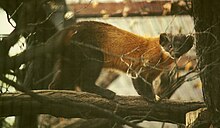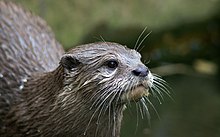marten
| marten | ||||||||||||
|---|---|---|---|---|---|---|---|---|---|---|---|---|
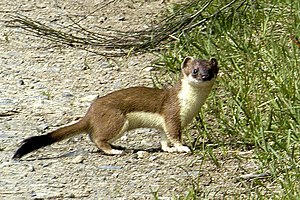
|
||||||||||||
| Systematics | ||||||||||||
|
||||||||||||
| Scientific name | ||||||||||||
| Mustelidae | ||||||||||||
| G. Fischer , 1817 |
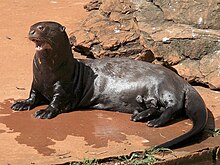

The martens (Mustelidae) are a family of canine-like predators (Canoidea). While the marten family also includes otters , badgers , polecats , minks and weasels , the colloquial language “marten” usually refers to the real marten ( Martes ) - including stone and pine marten . The skunks or skunks, which were also counted among the martens in the past, are now usually regarded as a separate family.
features
For most martens, an elongated, slender and supple body is typical, only badgers and wolverines are stocky and rather clumsy. The fur is mostly colored brown or black, with some species there are spots, stripes or throat markings. Several species have eye-catching facial markings made up of contrasting light and dark areas. The Eurasian badgers , for example, show a pattern of black and white ribbons. The benefits are not entirely clear. Possibly it should signal to potential predators that it is a defensive animal and thus deter them. Some species, such as the Tigeriltis , the Zorilla or the Libyan Striped Weasel , are clearly marked all over their bodies. These martens are able to expel smelly fluids from their anal glands. Northern species, namely the ermine , the long-tailed weasel and the mouse weasel , are able to change the color of their fur over the course of the seasons from white in winter to brown in summer. However, this extreme color change only takes place in the northern parts of the distribution of these species. The coloration is controlled by hormones and depends on the amount of daylight and the temperature. The tail of most martens is relatively long and hairy, but badgers have relatively short tails. The limbs are usually short, and each foot has five curved, non-retractable claws. The skull is characterized by a short snout and relatively small ears. The number of teeth varies depending on the type from 28 to 38, a characteristic feature is the loss of the second upper molar . Most martens have well-developed anal glands , similar to the skunks , whose secretion can be used to mark territory and, in some species, also for defense. The anal glands in the otters, however, are poorly developed and apparently completely absent in the sea otter. All martens have whisker hairs, which are particularly pronounced in otters so that they protrude from their heads even under water.
The physique of the different martens corresponds to their hunting and lifestyle. While the weasels are toe walkers, badgers can be considered real sole walkers. Some tree-living representatives of the family, such as the martens in the narrower sense (genus Martes ), move partly on the soles, partly on the toes. Weasels and polecats are elongated so that they can follow small animals into underground passages. Badgers also live partly underground and have a stocky body and powerful digging claws. Tree-dwelling martens are characterized by sharp climbing claws and long tails, which serve as a balancing organ. The semi-aquatic and aquatic martens, such as otters and mink, are characterized by elongated, torpedo-shaped bodies and powerful oar tails, some of which are even flattened on the sides. The water marten's legs are short and webbed. However, the mink only have incomplete webbed feet. The sea otters, whose hind feet are reminiscent of seals, are most adapted to aquatic life.
Compared to other predators, most martens are rather small, but the difference in size between the smallest and largest members of this family is considerable: It ranges from the tiny weasel , the smallest representative of predators at around 25 g in body weight, to the sea otters , giant otters and wolverines , which can weigh over 30 kilograms. Most species show a pronounced sexual dimorphism in terms of body size, males are on average 25% heavier than females. Male martens have a penis bone that is shaped differently in different species.
The teeth are very variable and their characteristics depend on the diet. Depending on the species, the martens have 28 to 38 teeth. All of them have the scissor bite , which is typical of predators , which is formed from the fourth upper premolar and the first lower molar. These are particularly sharp in specialized carnivores such as the weasels, while in others they are powerfully laid out and form a real breaker to break open hard shells. In particular, the sea otters, capotters and dwarf otters, which mostly live on shellfish, have strong fangs that are reminiscent of molars. In these species, the molars themselves are particularly strong. The canines of the martens are long, the incisors unspecialized.
distribution and habitat
Martens are widespread almost all over the world, they are only absent in the Australian - Ocean region, Madagascar , the Caribbean and other remote island groups, and in the Antarctic. The majority of the species of marten occurs in Eurasia. Africa is home to nine species of marten, South America is home to four different otters, two grisons (genus Galictis ), the Patagonian weasel and three species of mustela . Then there is the Tayra, which also inhabits the southernmost parts of North America. The South American otter and the large grison also inhabit parts of Central and North America in addition to South America. In addition, silver badger, wolverine, spruce marten, fishing marten, North American otter, mink and four weasel or polecat species (genus Mustela ) occur in North America . The two species of marten, ermine and weasel, were introduced to New Zealand by humans.
The different species of marten inhabit a variety of habitats , such as temperate and boreal forests, as well as tropical rainforests, steppes, savannas and tundra areas. However, they hardly penetrate into extremely dry habitats. Many species depend on the proximity of water and live along rivers and lakes, some also on the coast of the sea. The otters this affinity is pronounced water most, of sea otters even lives in the open sea of the North Pacific , and can be almost completely aquatic are living species. Since martens, being relatively small animals, are hunted by numerous larger predators, they are reliant on shelters as resting places. In many places several species of marten occur side by side. Seven species live side by side in the British Isles .
Way of life

The majority of the species are crepuscular or nocturnal, but some also go for food during the day. As many resting places Marder use self-dug or acquired from other animals burrows or other shelters. Many species live in the ground or, thanks to their slender shape, penetrate underground burrows when hunting, others often stay in trees. There are numerous excellent swimmers among the marten, especially the otters and the mink . Most species of marten are active all year round. Badgers hibernate in northern areas, however, as their food is then difficult to reach.
Social behavior
Martens are more solitary and territorial animals that mark their territorial boundaries with the secretion of their anal glands, with urine or feces. The sense of smell is very strong and is used to find prey and communication with other dogs, even the face and hearing are well developed. With the exception of some species of otter and the European badger, all species of marten are solitary animals. The females usually defend territories that are large enough to feed themselves and their offspring. The territories of the males are larger and always overlap with those of several females. As a rule, the territories of the males do not overlap with one another, females are more tolerant, but even with them only small areas of overlap seem to occur. The result is an intra-sexual territorial system that strongly overlaps with that of the opposite sex. The groups of the South American giant otters usually consist of a breeding pair and a few adolescents as well as the offspring of the respective year. Sea otters live in separate sex groups, which can sometimes be surprisingly large. The male groups of sea otters in Alaska sometimes comprise hundreds of animals. In contrast to the groups of females, the groups of males are only periodically stable and dissolve during the mating season. European badgers sometimes live in mixed-sex groups of up to 23 animals in the British Isles. Elsewhere in Europe, however, they are loners or live in pairs. Marten are usually quiet so as not to attract the attention of hunters and potential prey. Only when they come into direct contact with other animals or conspecifics can vocalizations be observed more frequently. Dwarf otters and giant otters, two species that live together in groups, have more than twelve or nine different sounds to communicate with each other.
Reproduction
The gestation period in martens is usually 30 to 60 days, but in many species there is a delayed implantation of the fertilized egg in the uterus , so that there can be several months between mating and birth. As a rule, the female only has a litter once a year. Newborn martens are nestled , they are born blind and helpless, but grow quickly. In most species, the young are independent after two months, sexual maturity usually occurs between half a year and two years. Life expectancy in the wild is usually five to 20 years.
food
Martens are primarily carnivores , but depending on the species and season they also eat plant-based food to a different extent. The prey spectrum of the members of this family is - also according to their size - considerable. What many species have in common, however, is that they hunt prey, which are often considerably larger than themselves. Some weasel species prey on much heavier rabbits , and wolverines attack animals the size of a reindeer .
All kinds of vertebrate animals , including small mammals , birds and their eggs, reptiles , amphibians and fish , but also insects , crustaceans , worms and much more, are on their menu. Vegetable foods include fruits , nuts and tubers .
Weasels and polecats ( Mustela ) as well as mink are pronounced carnivores that specialize in various small animals and only occasionally consume fruit or berries. Among them, ermines and long-tailed weasels hunt primarily rabbits and rodents, whereas mouse weasels hunt smaller rodents. Minks, on the other hand, are adapted to aquatic prey such as frogs, fish, crayfish and aquatic invertebrates. Real marten ( Martes ) are less specialized in meat. Depending on the season and availability, they also feed on larger parts of fruits and berries. Overall, however, they are mainly characterized by the fact that they are largely tree-living and are feared enemies of tree squirrels. The fishing marten also specializes in attacking Urson porcupines . Carrion also represents a considerable part of the food of this marten. The much larger wolverine is even more dependent on carrion as a source of food. Although he hunts himself, he often takes the remains of the prey from wolves. The sun badgers seem to feed mainly on small animals and invertebrates . Eurasian badgers ( meles ) are typical omnivores, while the North American silver badger can largely be described as carnivores. He sometimes forms hunting coalitions with coyotes to track down and dig up rodents living underground. The badger benefits from the coyote's fine sense of smell and the coyote from the badger's grave claws. Honey badgers mainly eat small animals, insects, roots and fruits and show a particular preference for honey. The otters feed mainly on fish, frogs and crustaceans. Sea otters eat mussels, sea urchins and fish on the seabed. To break open hard shells, the animals use stones as tools.
Relationship to people
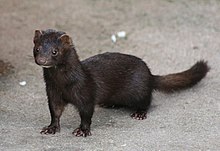
Humans have an ambivalent relationship to many species of martens, on the one hand they consume many rodents that are considered pests and are therefore kept as pets . The ferrets were even domesticated from the polecats for this purpose . On the other hand, they sometimes invade poultry or rabbit houses and tear down the animals there. They are also feared as "cable bites" (see marten defense ), although this only occurs in one species, the stone marten . The European badger is also known in the British Isles as a vector of bovine tuberculosis . In some places some species of marten are still being hunted down vehemently. In some regions of France, mouse weasel, polecat and stone marten are considered pests that can be legally caught in traps and killed.
Many species, including ermine , sable and mink, are hunted for their fur and sometimes kept on fur farms. The development of the North American continent was largely driven by fur hunters, who hunted various martens in particular. In addition to hunting, the destruction of their habitat is the main threat to many species of marten today. Above all, the disappearance of forests and water pollution are dangers. One species of marten, sea ore , became extinct in the 19th century due to excessive hunting. The most endangered species today include the European mink and the black-footed elk , which has already become extinct in the wild and only survived in captivity through breeding programs. In the meantime, the animals have been released back into the wild in the prairie areas of North America. In addition to these two species, the giant otter, the coastal otter , the sea otter, the southern river otter and the hair- nosed otter are endangered . As (endangered Vulnerable ) are Charsamarder , marbled polecat , clawed otter , smooth-coated otter and Colombian Weasel as Near Threatened ( Near Threatened ) are hog badger , wolverine, European badger, Eurasian otter and Altai weasel classified. The other species of marten are not threatened (35 species) or there is a lack of information to assess their status (6 species).
Systematics
The marten family has around 20 genera with around 60 species, making it the most species-rich family of predators. While the phylogenetic relationship of the martens is largely beyond doubt, the internal system has long been controversial. Wilson and Reeder (2005) divided the family into only two subfamilies, the otters (Lutrinae) and the Mustelinae, the latter supposed to include all other species except the otters. According to recent genetic investigations, however, the Mustelinae are to be regarded as paraphyletic , since various genera of this group are more closely related to the otters than to other representatives of the martens. Genetic studies have also shown that the honey badger and the silver badger form two separate lines of development that separated from the other species of marten particularly early. They can therefore be considered surviving members of their own subfamilies. The remaining martens form a group that can be divided into six further subfamilies. The badgers and the real marten represent two relatively early side branches, while the sun badgers, the Ictonychinae ( Grisons , Tigeriltis, Ictonyx , Poecilogale ), the otters and the Mustelinae (minks, polecats, weasels) form a group within which the otters and Mustelinae in turn form a sister group together. The position of the Patagonian weasel , which is compared to the weasels and minks in the system used here, has not been clarified .


|
The martens are divided into the following eight subfamilies:
-
Silver badgers (Taxidiinae)
- Silver badger ( Taxidea taxus )
-
Honey badgers (Mellivorinae)
- Honey badger ( Mellivora capensis )
-
Badgers (Melinae)
- Meles , 4 species, including the European badger ( Meles meles )
- Pig badger ( Arctonyx ), 3 species
-
Guloninae
- Real marten ( Martes ), 8 species
- Wolverine ( gulo gulo )
- Fishing marten ( pekania pennanti )
- Tayra ( Eira barbara )
-
Helictidinae
- Sun badgers ( Melogale ), 5 species
-
Ictonychinae
- Grisons ( Galictis ), 2 species
- Ictonyx with 2 species: Zorilla ( Ictonyx striatus ) and Libyan striped weasel ( Ictonyx libyca )
- Tigeriltis ( Vormela peregusna )
- White- naped weasel ( Poecilogale albinucha )
-
Mustelinae
- Mustela ( weasel , polecat , European mink and others), 17 species
- Neovison with the American mink and the extinct sea ore
- Patagonian weasel ( Lyncodon patagonicus )
-
Otter (Lutrinae)
- Old world otter ( Lutra ), 3 species
- Spot-necked otter ( Hydrictis maculicollis )
- Indian otter ( Lutrogale perspicillata )
- New World Otter ( Lontra ), 4 species
- Giant otter ( Pteronura brasiliensis )
- Finger otter ( Aonyx ), 3 species
- Sea otter ( Enhydra lutris )
A former subfamily, the skunks or skunks (formerly Mephitinae), are managed in a separate family, Mephitidae , according to genetic tests that showed only a more distant relationship to the martens . The stink badgers , which were originally also counted among the martens, also belong to this family according to genetic analyzes. The closest relatives of the martens are the small bears . The Mephitidae, on the other hand, broke away from the martens before the small bears split off and form a sister group to the other two families.
Tribal history
In terms of evolution, the martens are an ancient group of predators; they have been fossilized in Europe since the Eocene and in North America and Asia since the Oligocene . The spread of this group is at least roughly parallel to the development of rodents . In the late Miocene, about 12 to 9 million years ago, there was a first wave of specialization, during which today's main lines of martens emerged. This process was accompanied by the cooling of the earth's climate since the end of the Miocene , which resulted in the expansion of steppes and park-like landscapes. The more diverse vegetation zones are likely to have favored the variety of martens. In the Pliocene , around 5 to 2 million years ago, the global average temperature continued to drop, creating new habitats such as steppes, forest savannas and Nordic coniferous forests. This opened up new ecological niches for rodents and songbirds and thus also for martens as their enemies. As a result, most of today's genera developed in a second wave. Numerous species of the genus Mustela are specialized rodent hunters, several species of the genus Martes are dependent on the Nordic taiga areas.
The focus of evolutionary development was in Eurasia, where most of the subfamilies and genera developed. From there, various members of the family migrated over land bridges to other continents such as Africa and North and South America. This happened as early as the early Miocene with the martens of the subfamily Leparctinae, which is now extinct, and the so-called paleomustelids, which came to North America from Eurasia. At the end of the Miocene and the beginning of the Pliocene, newer genera such as Lutra (these could already represent the closely related American genus Lontra ) and Mustela migrated from Eurasia to North America via the Bering Land Bridge. Badgers in the narrower sense ( Actonyx , Meles ), which are now restricted to the Old World , also occurred on the border between the Miocene and the Pliocene in North America. The North American badgers, which are represented today by the silver badger, were also common in North America in the late Miocene with Chamitataxus and Pliotaxidea . The ermine, the black-footed elk, the weasel and the spruce marten may not have immigrated to North America from Eurasia until the Pleistocene. In Africa, the fossil record of martens is sparse, but the largest member of the family, Ekorus and the otter Vishnuonyx, is known from this continent . The martens reached South America 3 to 2 million years ago in the Pliocene, when the newly formed Isthmus of Panama enabled the great American fauna exchange between North and South America. All species in South America date back to North American immigrants. The giant otter, endemic to South America today, appears to be closely related to Satherium , an extinct genus from the time of the North American Pliocene. Ultimately, the origin of this genus, like that of other South American martens such as Grisons and Tayra, is probably in Eurasia.
literature
- Ronald M. Nowak: Walker's Mammals of the World . 6th edition. Johns Hopkins University Press, Baltimore 1999, ISBN 0-8018-5789-9 (English).
- John J. Flynn et al .: Molecular phylogeny of the Carnivora (Mammalia): Assessing the impact of increased sampling on resolving enigmatic relationships. Systematic Biology 54 (2), 2005, 1-21. ISSN 1063-5157 , doi : 10.1080 / 10635150590923326
- DE Wilson and DM Reeder: Mammal Species of the World . Johns Hopkins University Press, 2005. ISBN 0-8018-8221-4
- Larivière, S. & Jennings, AP (2009). Family Mustelidae (Weasels and Relatives) . In: Wilson, DE, Mittermeier, RA, (Eds.). Handbook of the Mammals of the World . Volume 1: Carnivores. Lynx Edicions, 2009. ISBN 978-84-96553-49-1
Web links
Individual evidence
- ↑ Larivière & Jennings, 2009 (p. 612)
- ↑ Klaus-Peter Koepfli, Kerry A. Deere, Graham J. Slater, Colleen Begg, Keith Begg, Lon Grassman, Mauro Lucherini, Geraldine Veron & Robert K. Wayne: Multigene phylogeny of the Mustelidae: Resolving relationships, tempo and biogeographic history of a mammalian adaptive radiation. BMC Biology 2008, 6:10 doi: 10.1186 / 1741-7007-6-10
- ↑ Lariviere & Jennings, 2009 (page 564)
- ↑ a b Fabio Oliveira do Nascimento. On the correct name for some subfamilies of Mustelidae (Mammalia, Carnivora). Papéis Avulsos de Zoologia (São Paulo). 54 (21): 307-313. doi: 10.1590 / 0031-1049.2014.54.21
- ↑ Ryan Paterson, Joshua X. Samuels, Natalia Rybczynski, Michael J. Ryan and Hillary C. Maddin. 2020. The Earliest Mustelid in North America. Zoological Journal of the Linnean Society. zlz091. DOI: 10.1093 / zoolinnean / zlz091
